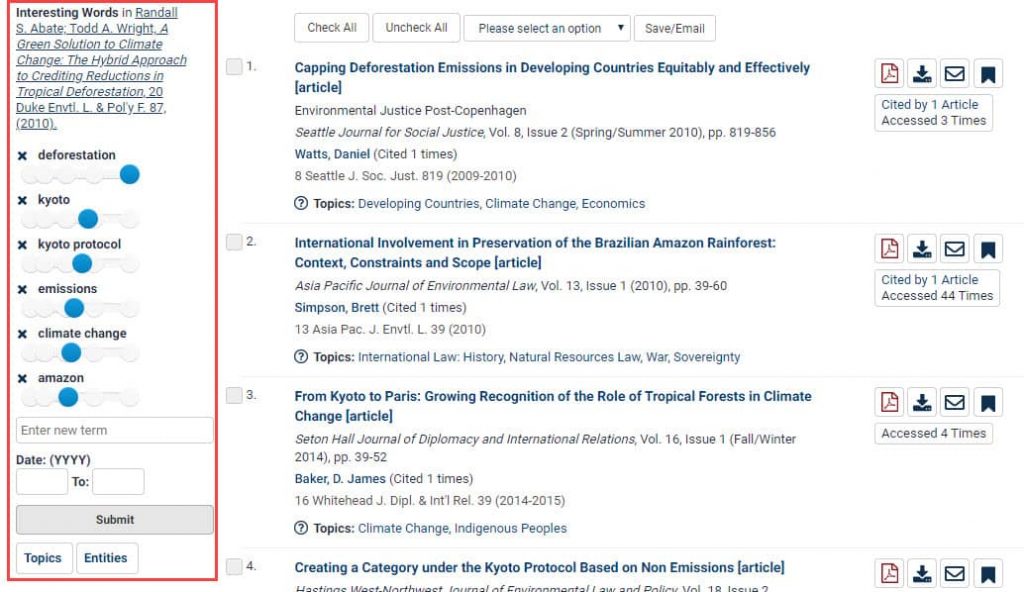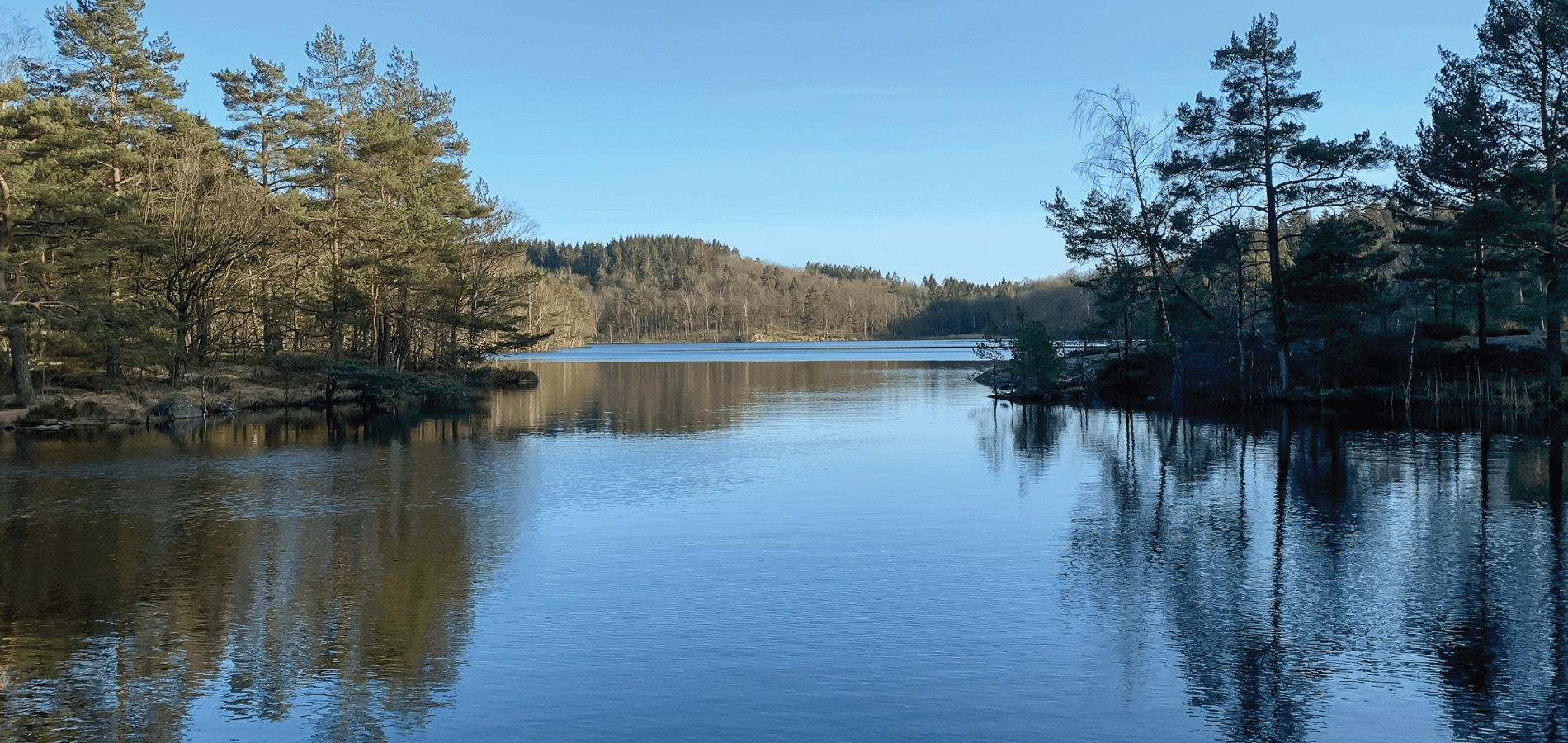This past August, a record number of wildfires ravaged the Amazon rainforest. In June, it was estimated that deforestation in the Amazon has risen by more than 88% compared to 2018. This increase in tree loss has sparked concerns about the fate of the Amazon and other forests across the globe. Learn about the environmental, societal, and economic importance of trees and discover current efforts to slow deforestation with HeinOnline.
Before We Get Started:
Don’t miss out! Make sure you have the databases we’ll be mentioning in this post. Follow the links below to start a trial today.
The Causes and Effects of Deforestation
Why does Deforestation Happen?
Deforestation is the clearing of forest land for non-forest uses such as farming, ranching, or city-building. A common practice throughout history, deforestation occurs primarily in tropical rainforests like the Amazon. In 2018, more than 3.6 million hectares of tropical forest were lost. Today, it is estimated that only 2.4 million square miles remain of the 6 million square miles of tropical rainforest which formerly existed on Earth. In the Amazon alone, an area approximately the size of a football field is cleared every minute.
Deforestation can be caused by several factors, both naturally occurring and man-made. According to the UN Framework Convention on Climate Change, the most significant direct cause of deforestation can be traced to agriculture, particularly the clearing of trees for subsistence farming, intensive commercial farming, and logging. Agriculture contributes indirectly, as well, as the slash-and-burn method of farming—the burning of forest plants to create fertile soil—increases the likelihood of starting powerful wildfires. It is estimated that 23% of global forest loss is a direct result of these fires.
Along with agriculture, other factors contributing to deforestation include climate change, overpopulation, urbanization, the corruption of government institutions, and economic incentives which hold forest conversion more profitable than conservation.
Why Does it Matter?
According to National Geographic, continuing the process of deforestation at the current rate will lead to the elimination of the world’s rainforests over the next hundred years. The impact of this loss is not just sentimental, but instead has far-reaching effects on the environment and human life.
Environmental Effects
Ongoing deforestation impacts several aspects of the Earth’s environment—namely, the Earth’s atmosphere, water cycle, soil, and wildlife.
- Effects in the Atmosphere:
While deforestation can be caused by global warming, it is also a major contributor. Tropical deforestation is responsible for an approximate 20% of greenhouse gas emissions. The loss of trees allows carbon dioxide to enter the atmosphere, creating a layer that traps radiation from the Sun and converts it to heat and thus contributing to increased temperatures each year. This process is known as “the greenhouse effect.” - Effect on the Water Cycle:
As one of their many functions, trees help regulate the water cycle which indirectly helps control the level of water in the atmosphere. Fewer trees leads to less water in the air, which ultimately leads to dryer soil and the inability to grow crops. - Effects on Soil:
In addition to the creation of infertile land, a loss of trees leads to the erosion of soil. Trees also function to reinforce the land with rich nutrients and to secure soil by lodging their roots in the ground. Without trees, nutrient-rich soil is washed away by rain and flooding, leaving barren land behind. - Wildlife:
According to National Geographic, 70% of the Earth’s plants and land animals live in forests. The removal of forests is, in effect, the removal of these species’ homes. In addition, the tree canopy created by thick forests regulates the temperature for various forms of wildlife. Eliminating these trees leads to the extinction of many species and facilitates a lack of global biodiversity.
Economic and Societal Effects
- Local Effects
As exposed land becomes barren and native species become extinct, indigenous peoples in forest areas lose the resources that they often rely on to survive. Around 250 million people living in forest areas depend on the trees, albeit indirectly, for their food and income. - Global Effects
On a broader scale, tree byproducts such as timber, fuel wood, paper, and more continue to play a significant role in the preservation of human societies, as they have since the beginning of civilization. In both developed and developing countries, the forestry industry is a major economic player. In the long term, the over-exploitation of forest products could lead to a decline in the supply and, as a result, a decline in the industry.
International Efforts to Slow Deforestation
While there is no international legislation that focuses only on forests, the topic is considered in a number of important global conventions and has been increasingly considered in the laws of many individual countries. Allow HeinOnline to help inform your understanding of these issues on an international and regional scale. First, discover the most relevant international conventions below:
- The United Nations Framework Convention on Climate Change (UNFCCC) is an international treaty adopted in 1992 to “stabilize greenhouse gas concentrations in the atmosphere at a level that would prevent dangerous anthropogenic interference with the climate system.” In order to achieve its goal, the UNFCCC laid the groundwork for future binding protocols and agreements on climate change.
- The Kyoto Protocol, added to the UNFCCC in 1997, is a legally binding agreement committing its parties to reduce greenhouse gas emissions. Entered into force on February 16, 2005, the protocol acknowledges that, based on their development, countries have varying abilities to combat climate change. To mitigate the effects of deforestation, the protocol allows countries to create and support sustainable development projects of reforestation (planting forests in previously deforested areas) and afforestation (planting forests in areas where there were none previously).
- The Paris Agreement, added to the UNFCCC in 2016, requires its parties to plan and regularly report on their contributions to slowing global warming. Article 5 of the agreement is primarily dedicated to forests, and specifically reducing forest-related emissions.
- The United Nations Convention on Biological Diversity, signed in 1992, outlined three goals: (1) the conservation of biological diversity, (2) the sustainable use of the components of biological diversity, and (3) the fair and equitable sharing of benefits arising from the use of genetic resources. The adoption of this treaty was the first international recognition that the conservation of biological diversity is important to humankind. As such, the treaty has significantly influenced global conversations concerning forests and their role in preserving biodiversity.
- The United Nations Convention to Combat Desertification in those Countries Experiencing Serious Drought and/or Desertification, particularly in Africa (UNCCD) was signed in 1994 to combat desertification and drought while promoting sustainable development. Toward this end, the treaty outlines long-term strategies to rehabilitate, conserve, and sustainably manage land and water resources. Part of these long-term strategies include the protection and expansion of forests.
After catching up on those important documents, utilize HeinOnline’s Law Journal Library to discover related legislation, journal articles, books, and more. Easily said, and easily done—HeinOnline’s unique natural language processing, machine learning, and research tools make research a breeze.
For example, enter the Law Journal Library and perform a full-text search for “deforestation” AND “climate change” in the main search bar. Users will immediately be redirected to more than 4,100 related results, including:
- The Lungs of Our Land: Deforestation and Climate Change’s Destructive Circular Relationship
- A Green Solution to Climate Change: The Hybrid Approach to Crediting Reductions in Tropical Deforestation
- From Kyoto to Paris: Growing Recognition of the Role of Tropical Forests in Climate Change
Looking for more great resources? Select one of the articles from the results and use HeinOnline’s More Like This tool to find similar articles. For example, select A Green Solution to Climate Change: The Hybrid Approach to Crediting Reductions in Tropical Deforestation. Find the More Like This button to the right above the article.
Users will be redirected to “interesting words” in the article, determined by an algorithm, and can adjust the terms and their respective weights to narrow the search.

Make sure you’re seeing both the forest and the trees. For more informative blogs on hot topics, click the Subscribe button on the upper right-hand side of this post.
Don’t forget to connect with HeinOnline on our social media platforms: Facebook, Twitter, Instagram and YouTube.



